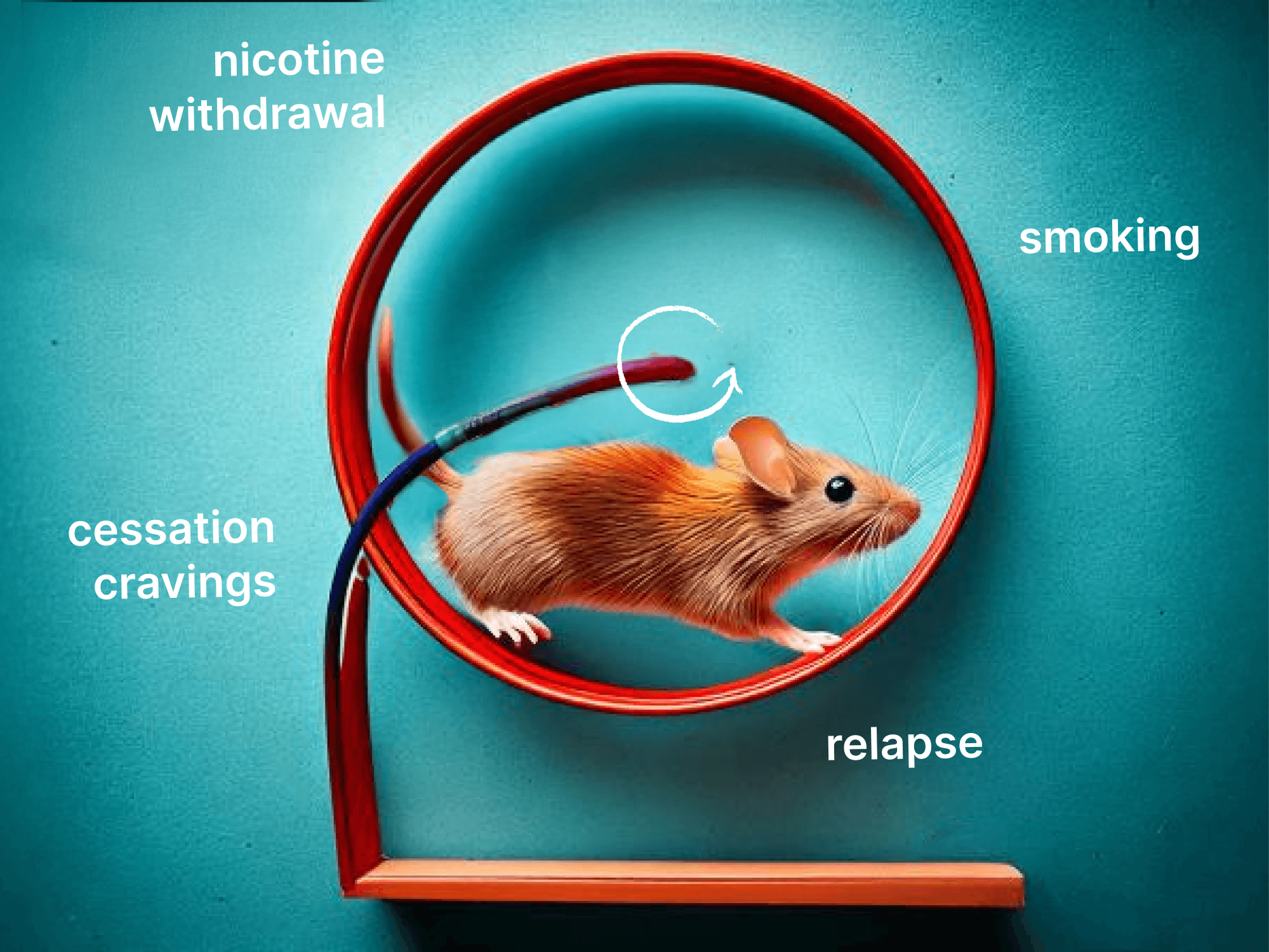Unbearable Withdrawal Cravings? The Smoking List Method Can Help You Quit
Start overcoming cravings with a science-backed approach
Daniel Stefan
Nov 12, 2024
8 min read

Imagine this: You've been smoking for years—perhaps decades—and no matter how many times you've tried to quit, every attempt ended in frustration. The cravings are unbearable, your body shakes, and your mind races, making it feel impossible to break free. It’s a tough battle, but you're not alone. Thousands of people face this same struggle every day, and many are still looking for a way out.
Research consistently shows that abrupt cessation is the most effective method for quitting, but for some, the cravings are simply too intense to bear all at once. So, what do you do when the urge to smoke feels overpowering?

That's where the Smoking Places List method comes in. This approach is designed for those who need help overcoming the most persistent cravings without the overwhelming shock of quitting cold turkey. Backed by research in behavioral interventions (Lopes et al., 2022) and neuroplasticity (Tang & Posner, 2016), this method helps your brain adapt and gradually reduce cravings, giving you the support you need to quit for good.
Curious to know how it works? Let’s dive into a real-life story and see how this method can help you finally break free from smoking.
I started smoking in 8th grade, thinking it made me look cool. Fourteen years later, in 2013, I finally found a way to quit.
Quitting cold turkey felt like diving off a cliff into freezing waters. Some people manage it, but for me, the cravings were unbearable. Within hours of my last cigarette, I’d be shaking and desperate to light up again.
I tried nicotine-blocking pills, but after a trusted doctor pointed out the side effects, I sought a better solution. That’s when I learned about how our brains adapt to habits. Just as drinking coffee regularly increases your tolerance, the same happens with nicotine. The good news? The brain can also adapt in reverse, making it easier to handle lower nicotine levels over time.
Instead of quitting outright, I designed a gradual approach. I made a list of all the places I smoked and systematically eliminated each one:
- In the car
- At work
- At home
- Home balcony
- At parties
- Outside
The first step? My car. I disliked the stale smoke smell, so I committed to no smoking in the car. Surprisingly, I didn’t experience any cravings. This small win gave me hope. If I could quit smoking in my car, what else could I tackle?
Every two weeks, I eliminated another smoking spot. As the number of places shrank, so did my cigarette consumption. My cravings lessened as my brain adjusted to the lower nicotine levels. It wasn’t a sudden miracle, but with each step, my addiction loosened its grip.
One of the most memorable milestones was quitting at parties. Most of my friends were smokers, and they were amazed when I refused cigarettes and didn’t seem bothered. Their admiration fueled my confidence and motivation, reinforcing that I was on the right track.
The last place I removed was outdoors. I remember my final cigarette outside a subway station with a friend. By then, my cravings were nearly gone, and quitting felt natural.
The key to my success? Combining the Smoking Places List to reduce cravings with the BravoBee program to break the smoking habit. The List targeted nicotine dependence by gradually reducing smoking contexts, while BravoBee helped me rewire the behaviors tied to smoking. Tackling both cravings and habits together made all the difference.
Here’s the takeaway: If quitting cold turkey feels impossible, gradual reduction with the Smoking Places List may be your breakthrough. It gives your brain time to adapt while helping you untangle ingrained habits. Every small step brings you closer to freedom.
If you’re feeling overwhelmed by the thought of quitting smoking, the Smoking Places List strategy is a game-changer. It breaks the daunting challenge of quitting into manageable steps, helping you gradually reduce and eventually eliminate your habit.
Step 1: List All Your Smoking Locations

Write down all the places you smoke and group them by type—like ‘parties’ or ‘outdoors’—instead of listing every event. Recognizing these locations is the first step to understanding your smoking triggers. Your list might include:
- In your car
- At work
- At parties
- At home
- In your garden
- Balcony
- On the street
- Outdoors
Step 2: Strike One Place Off the List Every 1-2 Weeks
With your list in hand, tackle one location every 1-2 weeks. Start small, maybe with your car or balcony—spots that feel manageable. Achieving small wins builds confidence and sets the stage for bigger successes. Each time you remove a place from your list, you’re weakening the habit, and reinforcing your ability to break free.
Step 3: Stick to the Remaining Locations
If cravings hit, smoke only in a location you’ve yet to quit—this reinforces control and helps you stick to your plan. For instance, after quitting smoking at my office, I felt the craving and stepped outside since “outdoors” was still on my list. This makes the process a little fun—and yes, even a bit crazy. Imagine telling friends, "I only smoke in my garden now." They might laugh, but soon enough, they'll admire your resolve, and some may even follow your lead.
It’s More Effective for Heavier Smokers
Heavier smokers often face more intense withdrawal symptoms, making abrupt quitting a daunting challenge. Gradual reduction provides a more tailored strategy for those with high nicotine dependence. According to the 2019 review, Gradual Reduction and Smoking Cessation in Heavy Smokers, this method significantly reduces withdrawal symptoms, increasing the likelihood of long-term success. By addressing both the physical and psychological facets of dependence, gradual reduction offers a lifeline for those who find cold turkey unsustainable.

It Leverages Neuroplasticity
Neuroplasticity might sound like a fancy term, but it’s the key to your brain’s ability to adapt to change—think of it as the brain’s way of rewiring itself. When you gradually reduce smoking, your brain starts to adjust to lower nicotine levels without the shock of quitting cold turkey, making cravings more manageable.
Tang and Posner (2016) explain that this stepwise approach enhances the brain’s capacity to adjust to lower nicotine levels, reducing dependency. Over time, the receptors that were once overstimulated by nicotine return to normal sensitivity, diminishing the physical hold of addiction.
It Weakens Triggers
Gradually eliminating smoking locations helps break the connection between specific environments and the urge to smoke. This concept is rooted in cue extinction, where repeated exposure to a smoking-related environment without engaging in the behavior gradually weakens the craving.
For example, a study by Lopes et al. (2022) shows that eliminating smoking at predictable moments, like during commutes, reduces relapse rates. By removing environmental cues, smokers can disrupt their conditioned responses and retrain the brain. Over time, this process rewires the brain, weakening the habitual craving loop.
Let’s suppose you decide to start with not smoking in the car.
Even if you're still in the car, the association with smoking isn’t instantly erased. Cue extinction occurs as you repeatedly drive without smoking. Eventually, your brain starts to unlink the environment (the car) from the habit (smoking). Each time you drive without lighting up, the urge weakens until the car no longer triggers the craving.
It Reduces Anxiety
Quitting cold turkey can feel overwhelming, triggering heightened stress and anxiety. Gradual reduction offers a less jarring alternative, minimizing withdrawal-induced distress. The 2019 study on Gradual Reduction and Smoking Cessation revealed that smokers who reduced their intake incrementally reported significantly less anxiety than those who quit abruptly. By maintaining a sense of control and progress, this approach fosters emotional resilience, making the quitting process more sustainable.
The journey to quit smoking can feel like an uphill battle, but the Smoking Places List method provides a scientifically-backed, manageable approach for those struggling with intense cravings and addiction.
Each step forward—whether it's quitting smoking in the car or at parties—builds your confidence and weakens nicotine's grip. By gradually removing smoking locations and allowing your brain to adapt, you can regain control over your habit without the overwhelming shock of quitting cold turkey.
This approach leverages powerful principles like neuroplasticity and behavioral interventions, which have been shown to significantly improve cessation rates and reduce withdrawal symptoms (Lopes et al., 2022; Tang & Posner, 2016).
Applying the Smoking Places List and addressing behavioral triggers with the BravoBee program, you have a two-pronged approach that tackles both the physical and psychological aspects of addiction. This combination maximizes your chances for success and provides comprehensive support on your journey to quitting smoking for good.

Studies:
(1) Behavioral interventions in smoking cessation
Findings: Behavioral interventions combined with gradual reduction improve cessation rates by approximately 32%, compared to unstructured reduction strategies.
Reference: Lopes LC, Zhang Y, et al., Annals of the American Thoracic Society, 2022.
(2) The Role of Neuroplasticity in Addiction Recovery
Findings: Habitual behaviors like smoking create strong neural pathways, but gradual reduction strategies promote rewiring through neuroplasticity, enhancing long-term cessation success. Personalized support (e.g., behavioral counseling or tailored interventions based on individual triggers) has been shown to improve outcomes by over 30%.
Reference: Tang Y-Y, Posner MI. "Neuroplasticity and smoking cessation," Science Advances, 2016.
(3) The Effectiveness of Gradual Reduction in Smokers with High Nicotine Dependence
Findings: Smokers with high levels of nicotine dependence experience less intense cravings and better outcomes when using a gradual reduction method compared to quitting abruptly. Gradual reduction enables a smoother transition, reducing withdrawal symptoms.
Reference: "Gradual Reduction and Smoking Cessation: A Review of Smokers with High Nicotine Dependence," Nicotine & Tobacco Research, 2019.
(4) Gradual Reduction and Emotional Stress in Quitting
Findings: Gradual reduction is associated with lower emotional stress compared to cold turkey quitting. Smokers reported reduced anxiety and increased confidence in maintaining cessation through stepwise approaches.
Reference: "Gradual Reduction and Smoking Cessation," American Journal of Public Health, 2019.
(5) Gradual Nicotine Reduction versus Abrupt Cessation: Comparative Effectiveness
Findings: Gradual reduction methods are effective for smokers struggling with abrupt cessation. A meta-analysis found that structured reduction strategies yield similar success rates to quitting cold turkey but are better tolerated by smokers with high dependence.
Reference: Lindson N, Klemperer E, et al. "Strategies for reducing cigarette consumption to help smokers quit," Cochrane Database of Systematic Reviews, 2019.